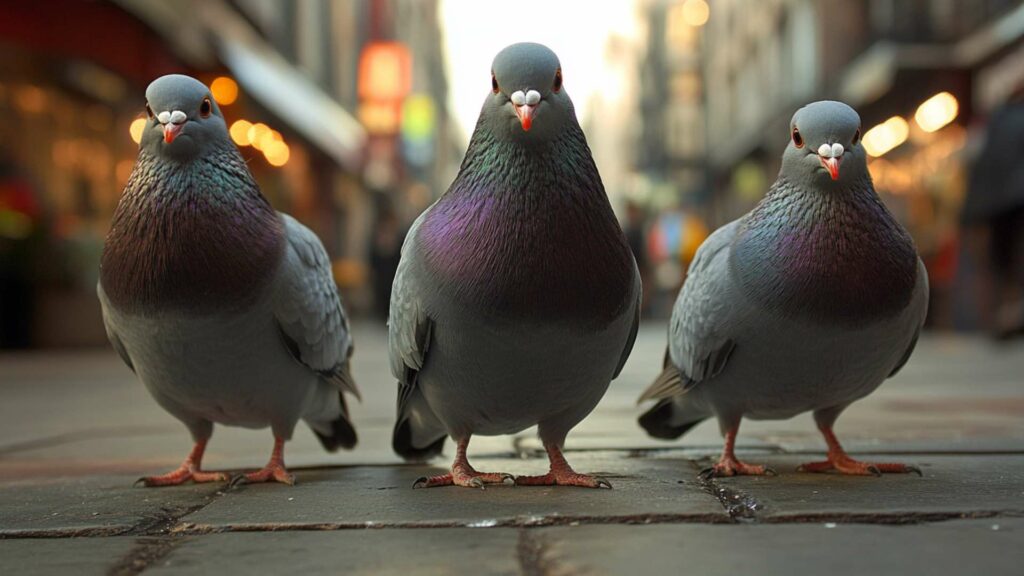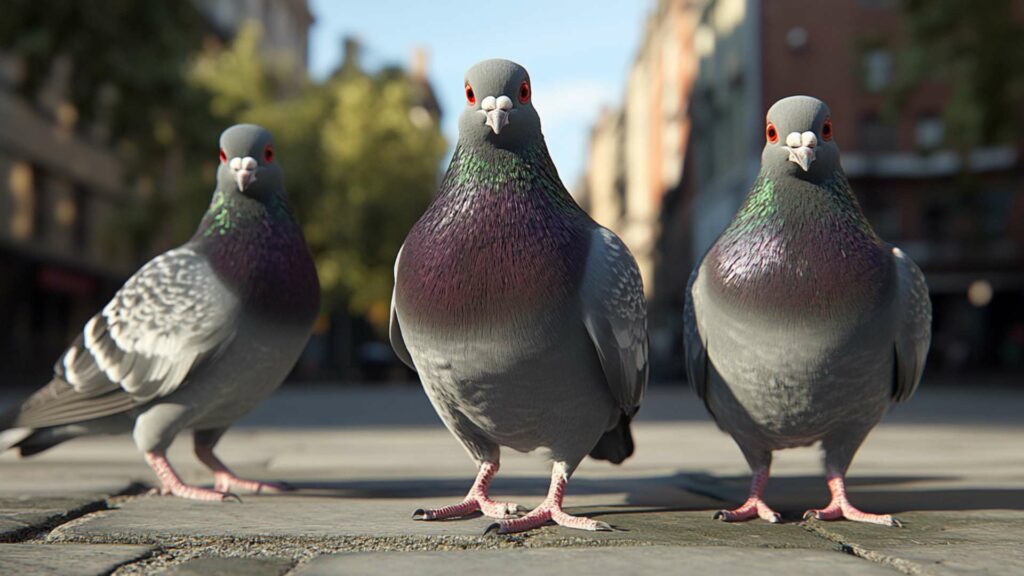Pigeons, those elegant and often overlooked avian creatures, are not only known for their distinctive cooing sounds but are also remarkable architects in their own right. Their nests, carefully constructed with meticulous attention to detail, provide a safe haven for their growing families. In this article, we will delve into the fascinating world of pigeon nest-building and explore the significance of understanding these structures.
Brief Overview of Pigeons as Nest Builders

Pigeons, scientifically known as rock doves (Columba livia), have been building nests since time immemorial. These resourceful birds can be found across various habitats worldwide, from bustling city streets to serene countryside landscapes.
When it comes to creating nests, pigeons exhibit remarkable ingenuity and adaptability. The male pigeon takes on the role of chief architect, working alongside the female pigeon to construct a sturdy home for their future brood of offspring.
Together they gather an assortment of nesting materials that consist of twigs, leaves, grasses, feathers – even bits of human-made debris such as scraps of paper or plastic. Combining these elements with precision and care, they fashion a cozy structure that will serve as a nest site their breeding ground.
Importance of Understanding Pigeon Nests

Studying pigeon nests is essential for gaining insights into the behavior and ecology of these captivating birds. By comprehending their nesting habits and preferences, we can better appreciate how pigeons adapt to different environments and navigate urban landscapes in particular. Furthermore, understanding pigeon nests allows us to develop effective strategies for managing these urban populations without resorting to harmful methods or excessive control measures.
As pigeons have become well-acquainted with human-dominated spaces – finding refuge on rooftops or ledges – comprehending how they establish and maintain their nests can help us mitigate potential conflicts and coexist harmoniously. Join us in the next sections as we delve into the intricate details of pigeon nest construction, exploring their architectural choices, preferred locations, and intriguing adaptations.
General Characteristics of Pigeon Nests
Size and Shape Variations: Where Size Meets Adaptability
When it comes to pigeon nests, one must marvel at the astounding variety in terms of size and shape. Pigeons, known scientifically as rock doves (Columba livia), are masterful builders that adapt their nests to fit the available space.
These resourceful birds can construct nests ranging from a modest 8 inches in diameter to a whopping 2 feet across. The size variation is not only influenced by the individual pigeon’s preferences but also by the constraints imposed by its nesting location.
In urban environments, where pigeons often take up residence on building ledges or other man-made structures, the size of their nests tends to be more compact. This is understandable given the limited space available in such settings.
On the other hand, when nesting on cliffs or other rocky surfaces, pigeons have greater freedom and tend to build larger nests with a broader diameter. It’s fascinating how these adaptable birds find unique solutions to accommodate their growing families.
Materials Used in Construction: A Blend of Practicality and Comfort

Pigeon nests reflect an impressive mix of practicality and comfort through their choice of construction materials. These resourceful avian architects utilize a diverse range of materials found within their immediate surroundings.
Primarily consisting of twigs and small branches, pigeon nests are thoughtfully woven together using interlocking techniques that enhance stability. To provide an added layer of coziness for themselves and their offspring, pigeons line their nests with soft materials such as grass, feathers, or leaves gathered from nearby vegetation.
Remarkably adaptive creatures that they are, pigeons have also been observed incorporating human-made materials into their nest-building repertoire as they adapt to urban environments. Stray bits of wood pigeon, of fabric or even discarded pieces of paper find new purpose in the intricate constructions that serve as the warm and secure homes for these charismatic birds.
By crafting nests with a combination of sturdy materials and plush linings, pigeons create a safe haven where they can make roosting together, incubate their eggs, and nurture their young. It’s awe-inspiring to witness how these seemingly common backyard birds exhibit such ingenuity in their home-building endeavors.
Construction Techniques and Locations
Urban vs Rural Preferences: Feathered Architects Amidst Concrete Jungles
Pigeon nests, those humble abodes crafted by these avian architects, can be found in both urban and rural environments. However, it is within the bustling metropolises that these charming feathered creatures have truly honed their nest-building skills.
The built environment of cities provides an array of unique nesting opportunities for pigeons. They ingeniously exploit the nooks and crannies provided by buildings’ architecture to construct their nests.
You may spot these bird-built dwellings nestled amidst building ledges, on window sills or even atop air conditioning units. In contrast, rural areas offer different options for nesting sites other birds.
Pigeons often favor the shelter of trees or cliffs when seeking a natural environment to build their nests. These locations provide not only protection from predators but also a sturdy foundation upon which they can construct their homes with confidence.
Height Preferences for Safety: Reaching New Heights to Protect Their Offspring
When it comes to selecting a nesting site, pigeons possess an inherent instinct for safety. Whether urban or rural, the pigeons nesting will typically prefer elevated locations that allow them to keep a watchful eye over potential threats while safeguarding their precious broods.
In urban settings, they gravitate towards taller structures that grant them a vantage point high above street level. This preference not only offers protection from ground-dwelling predators but also allows them easy access to food sources in the form of human waste.
Rural pigeon populations tend to choose elevated locations as well but often rely on natural formations such as cliffs or tall trees instead of man-made structures. This instinctual preference for height reflects the pigeons’ evolutionary adaptation as it reduces the risk of predation while enhancing breeding success.
Building Process and Collaboration: A Feathered Tango of Partnership and Efficiency
Pigeon nest construction is a dance of cooperation and efficiency. Once a pair of adult pigeons has selected a suitable nesting site, they engage baby pigeons in a fascinating display of teamwork to create their nest.
Pair bonding plays a crucial role, as both male and female pigeons actively participate in the building process. They gather nesting materials together, often seen carrying one stick or twig at a time in their beaks.
In an elaborate aerial ballet, they weave these materials into the foundation of their nest. The building process typically occurs over several days or weeks, depending on environmental conditions and the availability of resources.
Mid-morning hours are often favored rock pigeons for construction activities when there is ample daylight to aid visibility and secure food sources for energy replenishment. In this delicate tango of partnership and craftsmanship, each partner contributes to the creation of a safe haven where they will raise their young pigeons with tender care.
Nest Architecture and Design Features

Structural Integrity and Reinforcement Techniques
When it comes to the architectural marvels that are a pigeon’s nest of nests, structural integrity is of paramount importance. Pigeons exhibit a remarkable ability to construct sturdy nests by utilizing interlocking twigs and branches. These avian engineers meticulously arrange these natural materials, ensuring a secure and stable foundation for their homes.
The intertwining of branches not only provides strength but also creates a cozy and protective hideaway for the nesting birds. Additionally, pigeons employ ingenious reinforcement techniques to bolster the stability of their nests.
They often incorporate other elements such as grass stems or even bits of string into their construction, expertly weaving them into the nest’s framework. This method further fortifies the structure, making it resilient enough to withstand varying weather conditions and potential disturbances from predators or other elements.
Interior Design Elements: Nest Lining Materials
Just as humans prioritize comfort in their living spaces, pigeons pay attention to the interior design of their nests. They carefully select suitable materials to line their abodes, ensuring maximum comfort for themselves and their future hatchlings. Pigeons typically opt for soft grasses, feathers, or leaves as a primary lining and nesting material throughout.
These natural substances provide insulation against temperature fluctuations while offering a cozy surface on which eggs can rest securely. In an intriguing twist on interior design choices, some pigeons have adapted to incorporate human-made materials into their egg nests.
Urban environments often present limited availability of natural resources; thus, resourceful pigeons make use of man-made items like bits of fabric or paper scraps they find in urban areas. This adaptation showcases both the adaptability of these birds and their determination to create comfortable spaces even in challenging surroundings.
Nesting Habits and Adaptations
Seasonal Variations in Nesting Behavior
Pigeons exhibit intriguing nesting habits that are intricately tied to seasonal variations. During the breeding season, which varies depending on geographic region, pigeons display a strong preference for specific nesting sites. They seek out locations that offer safety and security, such as ledges or other elevated surfaces.
These spots rock pigeon can provide an ideal vantage point for monitoring their surroundings and protecting their nests from potential threats. Furthermore, pigeons are known for their ability to produce multiple broods per year.
This reproductive strategy is advantageous in maximizing their chances of successfully passing on their genes. By producing multiple clutches of eggs within a single year, they increase the likelihood that some offspring will reach sexual maturity and thus ensure the survival of their species.
Unique Adaptations in Urban Environments
In urban environments, pigeons have impressively adapted to man-made structures as alternative nesting sites. Rooftops have become popular choices for pigeon nests due to their elevated position and relative safety from ground-based predators. These adaptable birds have also exploited the presence of ledges or architectural features on buildings, transforming these spaces into comfortable homes where they can raise their young.
By embracing these urban adaptations, pigeons have managed to thrive alongside humans in busy cityscapes. Their ability to make use of man-made structures demonstrates not only their resilience but also serves as a testament to the remarkable adaptability and resourcefulness of these avian inhabitants.
Predators, Threats, and Protection Measures

Natural Predators Targeting Pigeon Nests
Despite having ingeniously constructed nests, pigeons face threats from natural predators. Birds of prey such as hawks and falcons pose significant dangers to pigeon nests located in open areas or rooftops due to aerial hunting capabilities. Opportunistic mammals like rats or raccoons can also pose a threat feral pigeons by attempting to raid nests in search of eggs or nestlings.
Human Interventions to Protect Pigeon Nests
Recognizing the importance of coexisting with these resilient birds, humans have implemented various measures to protect pigeon nests. One common intervention is the installation of deterrent devices, such as spikes or netting, in areas where pigeons frequently nest.
These physical barriers discourage pigeons from accessing certain spaces while ensuring their safety remains a priority. Moreover, conservation efforts specifically aimed at urban areas have emerged to safeguard pigeon populations.
These initiatives focus on raising awareness, promoting responsible urban planning, and adopting humane strategies to manage pigeon populations effectively. By striking a balance between human needs and avian well-being, these efforts showcase the harmonious cohabitation between birds and humans.
Conclusion
Pigeon nesting is a fascinating subject that unveils intricate details about these remarkable birds’ architectural skills and adaptive abilities. Their nests exhibit not only structural integrity but also intricate interior design elements that prioritize comfort for both parents and hatchlings alike.
With their seasonal variations in behavior and unique adaptations in urban environments, pigeons have proven themselves as resilient cohabitants in human-dominated spaces. While they face threats from natural predators, humans have recognized the significance of protecting pigeon nests by implementing interventions such as deterrent devices and conservation initiatives.
This mutual understanding fosters an environment where both humans and the pigeons nest and can peacefully thrive together. So next time you spot a pigeon nesting on your rooftop or perched on an urban ledge, take a moment to appreciate their resourcefulness and marvel at their ability to transform even the most unlikely places into safe havens for their young ones.
Repel Pigeons with D-Termination: The Foremost Pest Control Service in Las Vegas!

Confronting pigeon problems? D-Termination is your solution. Our team of specialists is dedicated to deterring pigeons, revitalizing cleanliness, and preserving the integrity of your environment. Bid farewell to pigeons by opting for D-Termination’s efficient pest control today!
Reach out to us at 702-919-6310 or visit dtermination.com to schedule your pigeon control service and reclaim your space from these bothersome pests.
Frequently Asked Questions:
A pigeon nest is often a simple collection of twigs, leaves, and debris, typically found on ledges or in sheltered areas.
Pigeons lay their eggs in nests, which are commonly situated on building ledges, trees, or other sheltered spots.
Pigeons commonly nest on building ledges, in trees, or in other sheltered locations.
Pigeons typically lay eggs in the spring and summer months.








